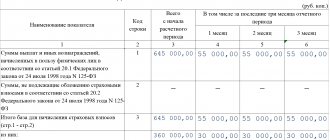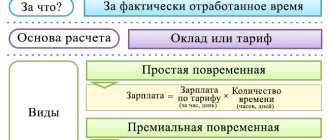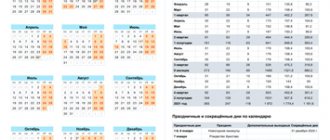What is standard working time and production calendar?
Before moving directly to the consideration of the issue of calculating working hours and drawing up the production calendar for 2021, we will define the basic concepts that will be discussed.
Standard working hours
– the number of working hours that an employee of an enterprise is required to work during the accounting period. The accounting period can be month, quarter and year. If a monthly accounting period is considered, the standard is determined based on daily indicators.
Production calendar
- this is a document that is a special-purpose calendar, formed taking into account weekends and holidays during which employees do not appear at the workplace, for the current year. The production calendar displays:
- work days;
- weekend;
- pre-holiday days;
- the holidays themselves;
- dates for postponing holidays.
Thanks to the production calendar, the personnel officer and accounting employee can see (quickly and without additional calculations) which days in the current year fall on holidays and weekends, and which working days will be shortened. Organizations use the production calendar for the following purposes:
- correct calculation of wages to subordinates;
- counting the number of working hours during a monthly period;
- formation of a work schedule for employees of different departments (and in the absence of such).
Average monthly number of calendar days: why is this indicator needed?
Calculation of calendar days
Back in Soviet times, people's working week consisted of six days. Accordingly, vacation was calculated taking into account the average monthly working days - 25.4. And working days were calculated like this: all holidays and Sundays were subtracted from 365 days, and then this number was divided by 12. But there were also leap years. For the accuracy of the calculations, these years were also taken into account and the average was calculated over several years.
Today, the law establishes a working week lasting five days and no more than 40 working hours per week. The average monthly number of calendar days is 29.3. From this you can calculate the average annual number of calendar days:
We multiply the average number of working days in a month by the number of months (29.3 * 12 = 361.6).
This number should be taken into account when calculating payment for vacation days and sick leave.
Holidays in 2021 (list)
The list of holidays has remained unchanged over the past few years. The list of holidays approved in the Russian Federation is presented in Article 112 of the Labor Code of the Russian Federation. These include:
| № | Holiday celebrated in Russia | Day on which the holiday falls |
| 1 | New Year (New Year holidays) | January 1-6, 8 (Wednesday-Monday, Wednesday) |
| 2 | Nativity | January 7 (Tuesday) |
| 3 | Defender of the Fatherland Day | February 23 (Sunday) |
| 4 | International Women's Day | March 8 (Sunday) |
| 5 | Labour Day | May 1 (Friday) |
| 6 | Victory Day | May 9 (Saturday) |
| 7 | Russia Day | June 12 (Friday) |
| 8 | National Unity Day | November 4 (Wednesday) |
Pre-holidays in 2021 (reduction of working hours by 1 hour)
On the days preceding official holidays, employees work 1 hour less than usual.
In 2021, this procedure applies to the following working days:
| № | Pre-holiday day | Holiday |
| 1 | April 30 (Thursday) | Spring and Labor Day (May 1) |
| 2 | May 8 (Friday) | Victory Day (May 9) |
| 3 | June 11 (Thursday) | Russia Day (June 12) |
| 4 | November 3 (Tuesday) | National Unity Day (November 4) |
| 5 | December 31 (Thursday) | New Year (January 1) |
Postponement of holidays in 2021
Important!
The annual postponement of holidays is carried out in order to more rationally use working time. It is mandatory to reschedule holidays for employees; the requirement applies to all employers in Russia.
Despite the fact that new holidays are not introduced, and previously adopted holidays are not cancelled, every year the Decree of the Government of the Russian Federation on the transfer of holidays comes into force, for the current year this is Resolution No. 875 of July 10, 2021. In 2021, the following transfer of holidays is carried out :
- instead of January 4 (Saturday), employees will have a rest on May 4 (Monday);
- Instead of January 5 (Sunday), workers will have a day off on May 5 (Tuesday).
As a result, “single” working days (those on the calendar between holidays and weekends) are eliminated from the work schedule, and employees have the opportunity to rest for several days in a row without reporting to the workplace:
- January 1-8,
- February 22-24,
- March 7-9,
- May 1-5,
- May 9-11,
- June 12-14,
- November 4.
We take into account holidays and weekends
Data on how many working days there are in a month, as well as the number of hours, is the basis for accounting operations. Article 112 of the Labor Code lists the days officially called holidays, i.e. non-working days. These are January 1-8, February 23, March 8, May 1, May 9, June 12, November 4.
If any of the listed dates coincides with a Sunday, the day immediately following it is declared an additional day off. This provision does not apply to the New Year holidays.
Salaries are calculated based on the number of days worked per month. This indicator (how many working days in a month on average), depending on the ratio of working days and weekends (including holidays), is used as a guide when calculating the amount of material remuneration. Such data is used, among other things, in statistics and analytics.
How is the standard working time calculated for 2021?
Important!
The employer (either independently or through the personnel department) is obliged to record the time actually worked by staff. An accounting sheet is used for this. When calculating wages and other payments provided for by the company’s remuneration system, an accountant must rely on the monthly standard and the number of hours actually worked by each employee.
First of all, when determining the standard working time, the personnel officer must check whether the enterprise employs special categories of workers for whom the law establishes special conditions in terms of the length of the working day and working week:
| № | Employee category | Standard working hours | Law |
| 1 | An ordinary employee for whom the law does not establish special working conditions (the general case of determining standard working hours) | A working week should be defined as no more than 40 hours. It turns out that if there are two days off (Saturday, Sunday), the daily working hours are set equal to 8 hours (40 hours: 8 hours) | Art. 91 Labor Code of the Russian Federation |
| 2 | Employees working in conditions recognized as harmful to health (according to the results of the assessment of environmental conditions - hazard classes 3 and 4) | 36 working hours per week | Art. 92 Labor Code of the Russian Federation, clause 1 of the Procedure, approved. By Order of the Ministry of Health of the Russian Federation of August 13, 2009 No. 588n |
| 3 | Minor employees under 16 years of age | 24 working hours a week | |
| 4 | Employees aged 16 to 18 years | 35 working hours per week | |
| 5 | Disabled people of groups 1 and 2 |
Important!
For special categories of employees, which are mentioned in the table presented above, the norm of daily working hours can be calculated as the quotient of the weekly norm of hours by 5.
When drawing up a production calendar, the enterprise employee responsible for this function must take into account not only holidays, but also pre-holiday days. The working day preceding a holiday must be shortened by 1 hour (as a result, the weekly working time rate is reduced by 1 hour)
.
It also happens that an enterprise is distinguished by certain features of its work schedule and/or production and other activities, as a result of which it is not possible to take into account the standard working hours (daily and/or weekly). The current labor legislation in such cases allows employers to introduce a summary recording of working time
, suggesting an increase in the accounting period. The maximum possible accounting period in such a situation may be 1 year (see Article 104 of the Labor Code of the Russian Federation). This should be understood to mean that the standard working hours for the whole year will be established - some days there will be more working hours, some less, some weeks will be more stressful, but in 12 months a strictly limited number of hours will be worked.
An example of calculating daily working hours for special categories of employees
The enterprise (printing) employs 50 people. Of these, 10 minors under 16 years of age (work as mail carriers), 5 disabled people of group 2 (work with photocopies) and 2 people who interact with substances harmful to health while working (work with photographs and films). The accountant is drawing up a production calendar and trying to determine the standard working hours for each employee:
- For children under 16 years of age, the weekly working time limit is 24 hours. This means that the daily working hours are:
- 24 hours : 5 hours = 4.8 hours
- For disabled people of group 2, the weekly working hours are 35 hours. Accordingly, the daily norm will be:
- 35 hours : 5 hours = 7 hours
- If an employee works under hazardous production conditions, as proven during an examination (SOUT), he cannot work more than 36 hours a week. The daily norm for them is:
- 36 hours : 5 hours = 7.2 hours
- The remaining 33 employees (50 – 10 – 5 – 2) have a daily working time limit of 8 hours
(40-hour work week).
How to calculate labor standards
In determining the normal duration of work, the order of the Ministry of Health dated August 13, 2009 No. 588n plays a decisive role.
The duration of work during the week, established for the employee, determines the norm for him. The basis is a calculation schedule containing five working days and two days of rest, as well as the duration of the working day or shift.
In the case where an employee has a work week of 40 hours, the duration of work per day is 8 hours; with a 36-hour week - 7.2 hours; at 24 hours - 4.8 hours. Existing work and rest regimes are determined by these figures.
On the eve of the holiday, the duration of work is reduced by one hour (Part 1 of Article 95 of the Labor Code of the Russian Federation). In 2020, such days fall on the following dates: 02/22, 03/07, 04/30, 05/08, 06/11, 12/31. If the Government approves the transfer of a day off to a working day, the duration of work is similar to the duration of the working day to which the day off is transferred. Thus, work on the specified dates will be shorter.
For example, let’s compare two months and see what the working hours are in April 2021 and what the working hours are in March 2020.
Calculation example
In April there are 22 working days and 8 days off (calculated as a work week of five working days and two days off).
The normal period (taking into account one day shortened by 1 hour) is:
- with a work week of 40 hours - 175 hours (8 hours x 22 days - 1 hour);
- at 36 hours - 157.4 (7.2 x 22 - 1);
- at 24 hours - 104.6 (4.8 x 22 - 1).
In March there are 20 working days and 11 days off.
The norm for the period will be (also with one shortened day):
- with a work week of 40 hours - 159 hours (8 x 20 - 1 hour);
- at 36 hours - 143 (7.2 x 20 - 1 hour);
- at 24 hours -95 (4.8 x 20 - 1 hour).
Monthly standard working hours (calculation)
To determine the monthly standard (upon completion of which the employee is entitled to full salary), it is enough to use the formula:
MNRCH = PRS x KRDM,
where MNRCH is the monthly standard working hours,
PRS – duration of the work shift,
KRDM – number of working days in a month.
If we are talking about a shortened work week (for special categories of employees), a different formula for calculating the monthly norm is used:
MNRF(C) = NNRF : 5,
MNRCH(S) – monthly standard working hours (shortened week),
ННРЧ – weekly norm of working hours.
How many working days should there be in a month?
But work schedules vary, which the employer informs the candidate about when hiring. All enterprises establish their own options based on production needs, but within the framework of current legislation.
The number of holidays determines how many working days there are in each month. Record holders in our country are January and May. We only have to work in them for about 17 - 18 working days. For comparison, in a typical month there are most often about 23 of them.
How to calculate how many working days are in 1 month? Subtract the number of weekends and holidays from 31 (or 30). The Labor Code regulates the maximum possible number of working days in each week. It is equal to 6.
That is, workers must be given at least one day off per week; working without any rest is prohibited.
Annual standard working hours (calculation)
There are 2 options for calculating the annual working hours for company employees:
- You can add up the previously calculated monthly norms.
- It is allowed to calculate the annual rate in the same way as the monthly one (then it is necessary to reduce the annual rate by 1 hour for each pre-holiday day, shortened due to the upcoming holiday - the list of such days was given above)
.
If the company has a standard working week (5 days) with two days off, in 2021 the annual working time will be calculated as follows:
| № | How many hours in a week? | Calculation of the annual rate | Annual Hours |
| 1 | 40 hours | 248 working days x 40 hours: 5 working days. days | 1 979 |
| 2 | 36 hours | 248 working days x 36 hours: 5 working days days | 1 780,6 |
| 3 | 24 hours | 248 working days x 24 hours: 5 working days days | 1 185,4 |
Common mistakes on the topic “Working time standards for 2021”
Error:
When calculating the annual standard of working time for employees of an enterprise, a personnel employee does not take into account days that were shortened by 1 hour due to the upcoming holiday.
On pre-holiday days, employees work 1 hour less than the allotted time (for example, with an 8-hour working day on the day before a holiday, the employee will work only 7 hours). In this regard, when calculating the annual norm of working hours, it is necessary to reduce the total number of working hours by 1 hour for each pre-holiday day.
Error:
The company's accountant takes into account Tatyana's Day, St. Valentine's Day and church holidays as a holiday.
Employees rest exclusively on holidays approved by the labor legislation of the Russian Federation. Other holidays that can be celebrated by Russians are not recognized as days off, and therefore are not taken into account by accountants and personnel departments of Russian enterprises.
Working time standards
Working week - 40 hours
According to Russian legislation, the longest working week should be 40 hours. This figure became decisive in determining the duration of the day shift.
Since the number of hours in all shifts must be the same, and 5 days are considered working days, it turns out that one shift is 8 hours.
However, there are different types of schedules that are communicated by the employer when hiring a person. Each individual enterprise sets its own work schedule, but it should not contradict current legislation.
Holidays affect the number of working days in a month. The largest number of holidays in the Russian Federation occurs in January and May. During these months, there are only 17 - 18 working days left. This is quite a bit compared to a normal month, in which there are about 23 working days. To find the number of working days, you need to subtract the number of Sundays and holidays from 31 (30).
The Labor Code specifies the maximum number of working days per week - 6. One day off is mandatory, so you cannot work 7 days a week without days off.
Answers to frequently asked questions about working hours in 2021
Question:
Is it necessary to shorten the working week for employees whose workplaces have been classified as hazardous class 2?
Answer:
No. The first and second classes of harmfulness do not imply a reduction in the norm of working hours per week. The working week is reduced only if hazard classes 3 and 4 are established.
Question:
Is it possible to enlarge the accounting period in order to carry out summarized accounting of working time up to 2 years?
Answer:
No. The maximum possible enlarged accounting period in such cases is 1 year.










